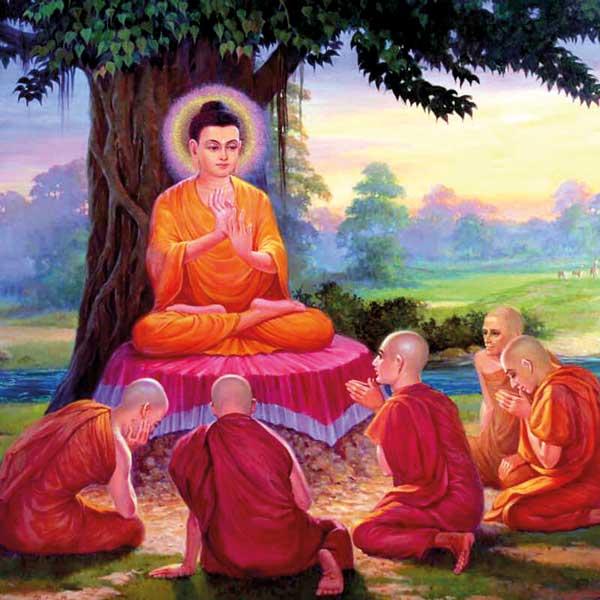Reply To:
Name - Reply Comment
 Duruthu Full Moon Poya Day, marks Buddha’s first visit to Sri Lanka nine months from his Enlightenment, he visited Mahiyangana, where now stands the Mahiyangana dagoba, to restore peace, and create a state of freedom from violence and convert a clan called the Yakkas of Bintenna. The chronicle says, Gautama Buddha offered some locks of his hair to Deity Sumana, which Relic he placed in an urn in the Mahiyangana Stupa. After listening to Buddha’s discourse the Yakkahs dropped their battle axes and paid admiration to the Buddha. Having restored calm among the Yakkahs, the Buddha returned to Jambudvipa. After Buddha’s parinibbana at Kusinara, Arahat Sarabhu Thera, brought the collar-bone Relic of the Buddha, and deposited it in the Mahiyangana Stupa. The attention of Buddhist is centred round Kelaniya temple which was hallowed by the Buddha’s third visit to Sri Lanka eight years after attaining buddhahood. Duruthu is also synonymous with religious activities in Kelaniya, The chronicle records that enshrined in the chaitiya built in Kelaniya is a gem-studded chair on which the Buddha sat and sermonized.
Duruthu Full Moon Poya Day, marks Buddha’s first visit to Sri Lanka nine months from his Enlightenment, he visited Mahiyangana, where now stands the Mahiyangana dagoba, to restore peace, and create a state of freedom from violence and convert a clan called the Yakkas of Bintenna. The chronicle says, Gautama Buddha offered some locks of his hair to Deity Sumana, which Relic he placed in an urn in the Mahiyangana Stupa. After listening to Buddha’s discourse the Yakkahs dropped their battle axes and paid admiration to the Buddha. Having restored calm among the Yakkahs, the Buddha returned to Jambudvipa. After Buddha’s parinibbana at Kusinara, Arahat Sarabhu Thera, brought the collar-bone Relic of the Buddha, and deposited it in the Mahiyangana Stupa. The attention of Buddhist is centred round Kelaniya temple which was hallowed by the Buddha’s third visit to Sri Lanka eight years after attaining buddhahood. Duruthu is also synonymous with religious activities in Kelaniya, The chronicle records that enshrined in the chaitiya built in Kelaniya is a gem-studded chair on which the Buddha sat and sermonized.
"All actions, according to the Buddha, what really matters
is thought"
It was in Kelaniya where the historic Duruthu Perahera is held by the Viharaya which stands on a mount by the Bank of Kelani river. The procession with a 93-year history depicts the ancient civilisation and cultural inheritance of the country including, folk music, folklore and many dance forms and South Indian drum beats which have got mixed up and developed around ‘Buddhism’. When the Duruthu full moon radiates its light over this thrice blessed island, Buddhists engage in meditation and meritorious deeds. Buddha conquered the Yakkha clan by standing before the congregation and radiating an aura of rays from his body, the chronicle says. Buddha Dhamma is profoundly imbued with the spirit of peace and harmony. Fear, hate and racial discrimination mar the progress of a nation and mainly the ordinary people.
Buddha did not form his significant philosophy of tradition in the same scientific method in which the Western philosophers endeavoured to interpret and scrutinise natural occurrences. The theory of regeneration, a feature of the prevalent tradition of his time - he acknowledged without questioning. Realising a way of becoming perfect or a way of escape from the continual succession of births and deaths was the main area he focused on.
Buddha and his Dhamma
Is the message more significant than the master ? History is stuffed with cases of those persons whose importance rests mostly on their ideas and little on their individual nature or lives. For good Buddhists, however, personality and character are crucially important. The enlightened one’s personality, his character, and his doctrine, is the Dhamma or his philosophy. The Dhamma is not transmitted from a God to us, through the Buddha. They are Dhamma expanded on by the Buddha after coming across instances which recognised their worth and after  careful analysis on their value. The proof and test of Dhamma is the Buddha; a major difference between Dhamma and other faiths. It is essential to know the Buddha’s personality, only through which we could learn more about the applicability of the Dhamma and our own ability to achieve accomplishment through it. We can assume with a high probability that the young Gautama, was a considerate person with a fair education, cleverly digested or been motivated by the sights which led to his abandonment of the ‘Sakya’ prince-hood.
careful analysis on their value. The proof and test of Dhamma is the Buddha; a major difference between Dhamma and other faiths. It is essential to know the Buddha’s personality, only through which we could learn more about the applicability of the Dhamma and our own ability to achieve accomplishment through it. We can assume with a high probability that the young Gautama, was a considerate person with a fair education, cleverly digested or been motivated by the sights which led to his abandonment of the ‘Sakya’ prince-hood.
"Rebirth may or may not be an immediate occurrence after a person’s death, so transfer of merit as carried out, cannot rationally be of
any gain to the deceased being"
Notwithstanding his status as a prince in lay life, and his reputation and admiration in the home base, his teachings were not right away popular or accepted by the people. He attracted a fair number of local following, with many dedicated to his doctrine. But his Dhamma was not an instant success, they challenged him. The traditional Jains-Hindu clans outnumbered the followers of the Buddha in the Southern Nepalese Ganges valley areas where the Dhamma was first introduced. Even among the followers of the Buddha, there had been quite a number of men who remained attached to their established religions. The Buddha never did get discouraged; he continually strived to sermonise the Dhamma to the people.
Merit Transfer is it Practicable?
Punna or punya is a concept in Buddhism and Hinduism, a concept that believes merit is accumulated and carries over through the samsara. Merit can be gained in a ten different ways as the Sutras suggest. According to the great vows of Ksitigarbha Bodhisattva Sutta of Mahayana sect, one can ‘transfer’ part of the merit of an act to a loved one who has passed away, to reduce the deceased’s misery in the new lives.
Some scholars of Buddhism, believed that the transfer of merit was rather discordant with Buddhist perception of Karma. Heinz Bechert, believes the doctrine was developed in an era between the 5th and 6th centuries. However, there are others who differ in their views, they say, it was an essential part of Buddhism experienced from Buddha’s times in India. ‘Buddhism’ as it stands today teaches that the accumulated merit can be transferred, can be shared with others; it is reversible and the persons who receive can be either living or dead.
The mode of transfer is quite simple; the doer has merely to wish that the merit he/she has gained accumulate to somebody in particular, or to ‘all beings’, a wish purely mental or expressed by words. All actions, according to the Buddha, what really matters is thought. Transference is mainly an act of the mind. Some waste on worthless rituals and performance in commemoration of departed ones. They must realise that it is not possible to assist the dead simply by building tombs, graveyards, monuments and other stuff; instead doing some praiseworthy acts like, help the needy, building schools, temples, libraries, orphanages and hospitals….
Milindapanha
In the Milindapanha the King Milinda expresses the idea that if the beneficiary is not mindful of a merit being presented, the giver gets no benefit thereby. Naagasena thera quotes a few examples to prove that it is wrong. The discrepancy is that the act of transfer is an act of unselfishness and the feedback of the action on oneself has a purification effect, as well as on the person to whom the act is aimed. Naagasena says, “If a person transfer merit, that merit develops and grows more and more, during the act of transferring it, and the merit of that performance he is able to distribute to whomsoever he will.”
"Some waste on worthless rituals and performance in commemoration of departed ones"
Rebirth may or may not be an immediate occurrence after a person’s death, so transfer of merit as carried out, cannot rationally be of any gain to the deceased being. He would have to bear the weight for the kamma that is owing to him. The transfer of merit for a deceased will though benefit the giver as it should make a sense of compassion in that person. The practice of offering alms to Sangha on seventh day and third month, followed by annual dane accompanied by a large gathering of friends and relatives have become a standard ritual and a mere waste of food. Animal flesh of numerous varieties are consumed by, all concerned with the aim of transferring ‘merit’ to their loved one.
How do they know, or what makes them so sure that the carcass of the seer fish that they bought encouraging the slaughterer to kill more next day and make those sumptuous deep fried slices do not belonged to their loved one who died a few years before and reborn an aquatic animal? They now enjoy the flesh along with the high priest of the very temple the deceased was a dhayake with a host of friends and relatives joining them.
May all beings be happy!